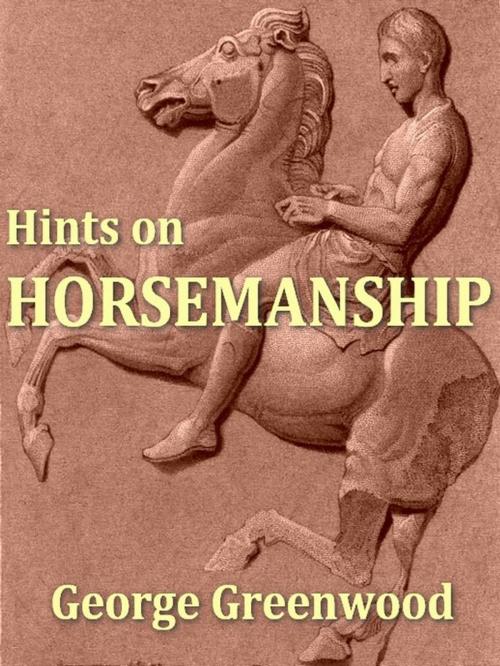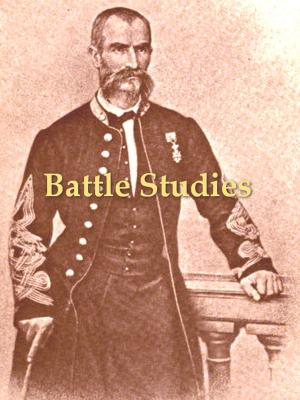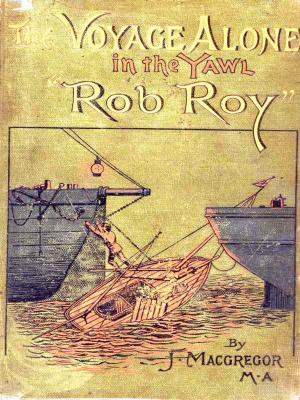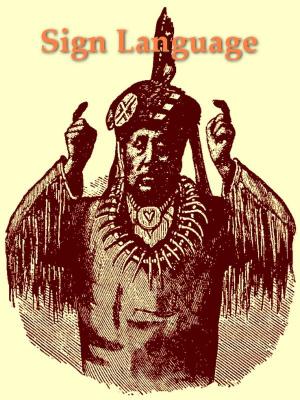Hints on Horsemanship
Or, Common Sense and Common Errors in Common Riding
Nonfiction, Science & Nature, Nature, Animals, Horses, Pets, Sports, Horse Sports, Equestrian| Author: | George Greenwood | ISBN: | 1230000142200 |
| Publisher: | VolumesOfValue | Publication: | June 15, 2013 |
| Imprint: | Language: | English |
| Author: | George Greenwood |
| ISBN: | 1230000142200 |
| Publisher: | VolumesOfValue |
| Publication: | June 15, 2013 |
| Imprint: | |
| Language: | English |
Hints On Horsemanship, to a Nephew and Niece
Or, Common Sense and Common Errors in Common Riding
BY COLONEL GEORGE GREENWOOD, AN OFFICER OF THE HOUSEHOLD BRIGADE OF CAVALRY.
Late Lieut.-Col. commanding 2nd Life Guards.
This edition features
• illustrations
• a linked Table of Contents
CONTENTS
CHAPTER I. MILITARY RIDING NOT FIT FOR COMMON RIDING.
Throughout Europe there is only one style of riding taught
That is the soldier's one-handed style
Two hands should be used to the reins
A soldier's horse must turn on the wrong rein
Common riders generally turn their horses on the wrong rein
Result of this with colts or restive horses
Indications are not aids
CHAPTER II. HOLDING AND HANDLING THE REINS.
Reins at full length
The downward clutch
The Grecian mode of holding and handling the reins
The side clutch
The two reins crossed in one hand
A rein in each hand
Turn to the right, and left
The hunting hand
The rough-rider's hand
Fixing the hands
Use of both bridles at once
Shortening the reins when held one in each hand, system of taught, and of untaught horsemen
Use of the whip
Horses swerve and turn only to the left
Fault in “the great untaught,” two-handed, English rider
CHAPTER III. EFFECT OF INDICATIONS.
Retaining, urging, and guiding indications
To make a horse collect himself
Canter, right turn, right pass
Left shoulder in
Bearing on the mouth
The horse must be made to collect himself in turning
And should not be turned on one rein only
Lady's canter
The quicker the pace, the greater degree of collection
French and English mistake in this
The shy horse
The restive horse
Truth may be paradoxical
CHAPTER IV. MECHANICAL AID OF THE RIDER.
The rider cannot raise the falling horse
Harm is done by the attempt
The bearing-rein
Mechanical assistance of the jockey to his horse
Standing on the stirrups
Difference between the gallop and the leap
Steeple-chases and hurdle-races unfair on the horse
The rider should not attempt to lift his horse at a fence
CHAPTER V. THE SEAT.
There is one direction which applies to all seats
Different seats for different styles of riding
The manège and the Eastern seats are the extremes
The long stirrup is necessary for cavalry to act in line
Medium length of stirrup for common riding
CHAPTER VI. MOUNTING AND DISMOUNTING.
Directions to place a lady in her saddle
Directions to mount at a halt
To mount in movement
To dismount in movement
To vault on or over in movement
To vault on at a halt
Circus for practising these movements
To pick a whip from the ground
To face about in the saddle
CHAPTER VII. THE BIT.
Place of the bit in the horse's mouth
Principle of the bit
Action of the common bit
Action of the Chifney bit
The loose eye
The nose-band
The horse's defence against the bit by the tongue
Effect of the porte against this defence
Defence of the horse by the lip
Defence by the teeth
Bar of the military and driving bit
Martingale
Danger does not result from power
CHAPTER VIII. THE SADDLE AND SIDE-SADDLE.
A side-saddle should have no right hand pummel
The leaping-horn
Surcingle
Stirrup-leather
Stirrup-iron
Girthing
To avoid riding on the buckles of the girths
CHAPTER IX. THE SHORT REIN.
The short rein should be used when one hand is occupied
Its use to a soldier
Its use with the restive horse
It should not be used in hunting, or in swimming a horse
Objection to it for common riding
Used by postilion
Short rein of the Eastern horseman
CHAPTER X. COLT-BREAKING.
Colt-breaking is the best possible lesson for the rider
The head-stall
The snaffle
Longeing
Saddling
Mounting
Sermon to the colt-breaker
The noblest horse resists the most
The horse has a natural right to resist
The colt wants no suppling
He wants to be taught the meaning of your indications
And to be brought to obey them
The leaping-bar
Fetch and carry
CHAPTER XI. THE HORSE AND HIS STABLE.
Condition depends on food, work, and warmth
So does the difference between the breeds of horses
The terseness of the Arab is the result of hard food
So is that of our thorough-bred horse
Different breeds result from different natural conditions
Crossing only necessary where natural conditions are against you
We do not attend enough to warmth
We should get fine winter coats by warmth, instead of singeing
No fear of cold from fine coats
The horse's foot should be stopped with clay
The sore ridge
Stable breast-plate
The head-stall
Never physic, bleed, blister, or fire your horse
Food for condition
Rest for strains
Nature for wounds
Miles for shoeing
The horse should have water always by him
And should stand loose
No galloping on hard ground, either by master or man
He who cripples the horse kills him
Hints On Horsemanship, to a Nephew and Niece
Or, Common Sense and Common Errors in Common Riding
BY COLONEL GEORGE GREENWOOD, AN OFFICER OF THE HOUSEHOLD BRIGADE OF CAVALRY.
Late Lieut.-Col. commanding 2nd Life Guards.
This edition features
• illustrations
• a linked Table of Contents
CONTENTS
CHAPTER I. MILITARY RIDING NOT FIT FOR COMMON RIDING.
Throughout Europe there is only one style of riding taught
That is the soldier's one-handed style
Two hands should be used to the reins
A soldier's horse must turn on the wrong rein
Common riders generally turn their horses on the wrong rein
Result of this with colts or restive horses
Indications are not aids
CHAPTER II. HOLDING AND HANDLING THE REINS.
Reins at full length
The downward clutch
The Grecian mode of holding and handling the reins
The side clutch
The two reins crossed in one hand
A rein in each hand
Turn to the right, and left
The hunting hand
The rough-rider's hand
Fixing the hands
Use of both bridles at once
Shortening the reins when held one in each hand, system of taught, and of untaught horsemen
Use of the whip
Horses swerve and turn only to the left
Fault in “the great untaught,” two-handed, English rider
CHAPTER III. EFFECT OF INDICATIONS.
Retaining, urging, and guiding indications
To make a horse collect himself
Canter, right turn, right pass
Left shoulder in
Bearing on the mouth
The horse must be made to collect himself in turning
And should not be turned on one rein only
Lady's canter
The quicker the pace, the greater degree of collection
French and English mistake in this
The shy horse
The restive horse
Truth may be paradoxical
CHAPTER IV. MECHANICAL AID OF THE RIDER.
The rider cannot raise the falling horse
Harm is done by the attempt
The bearing-rein
Mechanical assistance of the jockey to his horse
Standing on the stirrups
Difference between the gallop and the leap
Steeple-chases and hurdle-races unfair on the horse
The rider should not attempt to lift his horse at a fence
CHAPTER V. THE SEAT.
There is one direction which applies to all seats
Different seats for different styles of riding
The manège and the Eastern seats are the extremes
The long stirrup is necessary for cavalry to act in line
Medium length of stirrup for common riding
CHAPTER VI. MOUNTING AND DISMOUNTING.
Directions to place a lady in her saddle
Directions to mount at a halt
To mount in movement
To dismount in movement
To vault on or over in movement
To vault on at a halt
Circus for practising these movements
To pick a whip from the ground
To face about in the saddle
CHAPTER VII. THE BIT.
Place of the bit in the horse's mouth
Principle of the bit
Action of the common bit
Action of the Chifney bit
The loose eye
The nose-band
The horse's defence against the bit by the tongue
Effect of the porte against this defence
Defence of the horse by the lip
Defence by the teeth
Bar of the military and driving bit
Martingale
Danger does not result from power
CHAPTER VIII. THE SADDLE AND SIDE-SADDLE.
A side-saddle should have no right hand pummel
The leaping-horn
Surcingle
Stirrup-leather
Stirrup-iron
Girthing
To avoid riding on the buckles of the girths
CHAPTER IX. THE SHORT REIN.
The short rein should be used when one hand is occupied
Its use to a soldier
Its use with the restive horse
It should not be used in hunting, or in swimming a horse
Objection to it for common riding
Used by postilion
Short rein of the Eastern horseman
CHAPTER X. COLT-BREAKING.
Colt-breaking is the best possible lesson for the rider
The head-stall
The snaffle
Longeing
Saddling
Mounting
Sermon to the colt-breaker
The noblest horse resists the most
The horse has a natural right to resist
The colt wants no suppling
He wants to be taught the meaning of your indications
And to be brought to obey them
The leaping-bar
Fetch and carry
CHAPTER XI. THE HORSE AND HIS STABLE.
Condition depends on food, work, and warmth
So does the difference between the breeds of horses
The terseness of the Arab is the result of hard food
So is that of our thorough-bred horse
Different breeds result from different natural conditions
Crossing only necessary where natural conditions are against you
We do not attend enough to warmth
We should get fine winter coats by warmth, instead of singeing
No fear of cold from fine coats
The horse's foot should be stopped with clay
The sore ridge
Stable breast-plate
The head-stall
Never physic, bleed, blister, or fire your horse
Food for condition
Rest for strains
Nature for wounds
Miles for shoeing
The horse should have water always by him
And should stand loose
No galloping on hard ground, either by master or man
He who cripples the horse kills him







![Cover of the book Wood-carving [Illustrated] by George Greenwood](https://www.kuoky.com/images/2013/january/300x300/1230000097062-mnr9_300x.jpg)







